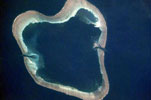Scott & Seringapatam Reefs
 Located in the Timor Sea over 300 km northwest of Cape Leveque, on the edge of the Australian continental
shelf, lie the three reefs collectively known as the Scott & Seringapatam Reefs. The three separate units
consist of the Scott Reefs in the south — comprising Scott Reef North and Scott Reef South — and
the more northerly and smaller Seringapatam Reef. They are part of the same chain of reefs and banks that lie
in this region of the Timor Sea known as the Scott Reef/Rowley Shoals platform that includes the
Rowley Shoals to the southwest.
Located in the Timor Sea over 300 km northwest of Cape Leveque, on the edge of the Australian continental
shelf, lie the three reefs collectively known as the Scott & Seringapatam Reefs. The three separate units
consist of the Scott Reefs in the south — comprising Scott Reef North and Scott Reef South — and
the more northerly and smaller Seringapatam Reef. They are part of the same chain of reefs and banks that lie
in this region of the Timor Sea known as the Scott Reef/Rowley Shoals platform that includes the
Rowley Shoals to the southwest.
Each of the reefs is a small, reef-topped, carbonate platform that rises steeply from the sea bed (400-500 m below), and although closely spaced, each is separated from its neighbours by channels of deep water. Much of the reefs are dry or become exposed at low tide, but with the exception of emergent rocks, drying sand patches and the small unvegetated Sandy Islet off Scott Reef South, they contain no permanent land.
Scott Reef South — also known as Horseshoe Reef — is the most unusual of the reefs, being a large (144 km²) crescent-shaped formation that has a rare and unusual double reef crest. Off West Hook (the western tip of the crescent) sits the smaller reef of Sandy Islet (sometimes referred to as Scott Reef Central). Scott Reef North — the central member of the three reefs — consists of a large, approximately circular-shaped, reef lying 23 km southwest of Seringapatam Reef. The reef, covering 106 km², is composed of a narrow reef-crest that is backed by broad reef flats — much of which becomes exposed at low tide — and a deep central lagoon that is connected to the open sea by two delta-like channels.
Located around 23 km north of Scott Reef North lies the small circular-shaped reef of Seringapatam — the most northerly of the three reef structures that comprise the Scott & Seringapatam Reefs. The formation, covering an area of 55 km², rises abruptly from the sea bed with its narrow reef rim enclosing a relatively deep lagoon. Much of the reef becomes exposed at low tide, as do some areas of low sandbank on the western side.
The Scott & Seringapatam Reefs are but one group amongst a number of reef formations that lie of the northwest coast of Australia. Further to the northeast lies Ashmore Reef & Cartier Island, and to the southwest are the reefs of the Rowley Shoals. For islands and reefs that lie closer to the Australian mainland see the Kimberley coast.




